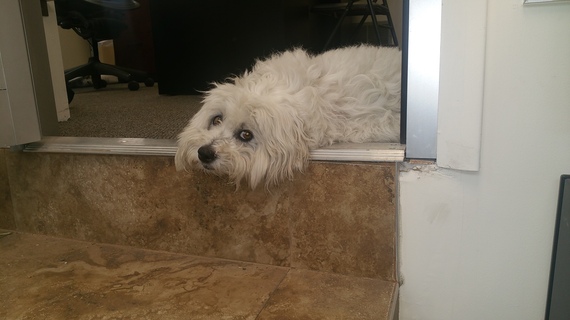Photo by Marc Khlar, Alfie
Does your dog pace when you reach for the car keys, rip a few cushions while you're out, or jump all over you upon re-entry?
How about your walks? Is it really your dog who takes you for a walk? Does he drag you along or launch into aggressive dramas when something passes by or approaches you?
If you're embarrassed by your dog's unsettled and wild behavior, remember, you're not alone. Separation anxiety and leash aggression are the #1 and #2 problems of the 21st century (according to me). While housebreaking and jumping topped the list for a decade, they've taken a backseat. Why?
Modern lifestyles have increased work and play outside of the home. Frequent comings and goings are distressing, signally isolation each time you leave. Busy schedules, children who stay after school for clubs, sports, and other activities, work commitments -- modern households hold little excitement anymore. What's a dog to do?
Such long hours spent alone, often in silence, is not good for anybody, least of all a sociable dog. Latchkey canines slowly go insane if left to their devices. Distraught, they relieve their stress the only way they know how: pacing, chewing, and general agitation. All this activity often leads to pottying because realistically, how can a dog hold it when he's upset?
When the dog's parent or family members do come back to see their house turned upside down, they get mad, thinking their dog misbehaved to spite them. Thoughts like these lead to reprimands that scare the dog but end there. Dogs can't comprehend after the fact corrections any more than a toddler could: what they do notice is that when isolation ends, the reprimands begin. Now the dog has yet another reason to fear being left alone, which leads to more destruction, which leads to more frustration, reprimands, and so on and so on.
Within a few days, a dog who'd have otherwise been a stable, happy companion is now a destructive, groveling, anxious mess.
Compare this to the leash-aggressive dog whose relentless pulling never leads to freedom. Unless positively conditioned to cooperate (with surprise rewards, games, and earned exploration sniffing) a dog will lose his marbles. People dragging becomes the new sport; barking at or jumping on a passerby, the chief excitement; leash aggression, the most effective way to control the surroundings.
No matter how far you're into the vicious cycle, you'll need an adjustment. What's a loving dog parent to do?
Separation anxiety and leash aggression have a lot in common -- more than may meet your eye. These problems crop up between 9 months and 3 years of age. Although they may seem to develop out of the blue, they often can be traced back to puppyhood, especially if proper socialization was put on the back burner.
Fortunately, with understanding and a well-thought out approach, both can be quickly managed or resolved.
The first step is to acknowledge your dog's perspective. Then, and only then, can I help you craft your solution.
Remember, dogs and toddlers have a lot in common. If you consider one, you'll understand the other. Dogs who are reactive, like unrelenting children, are not happy.
Like kids, dogs hate unknowns and act out when they feel out of control. If anxious and leash-aggressive dogs could talk, I imagine they'd say, "Where did everybody go?" "Why do you keep leaving me here by myself?" "Why do you keep insisting on pulling me away from things I like?"
For now, play detective. Watch your dog and record his triggers: the things that set him off. Does he stress the minute you reach for your car keys, your briefcase, or your purse? Do you isolate him when you go; if so does he resist you?
What alerts him during your walk? Does he pull non-stop or only when he sees another dog, or person or anything that moves? List each distraction and see if you can prioritize your list from most distracting to least.
Do you know your dog's stress signs -- what he does when he starts feeling trapped or out-of-control? Everyone has stress symptoms -- ways they act when they're unable to cope with a situation. A person might bite their nails, twirl their hair or raid the refrigerator; a dog will bark, chew, lunge, or act out in other ways.
If you're having trouble with this assignment, take a minute to think of it from your perspective: what rattles your nerves? Traffic, clueless tech support and long lines at the coffee shop are what get me going.
People use stress-relieving activites to bring them back to center. I garden, play with the dogs or go for a hike. What do you do?
Think of ways your dogs could relieve some of his stress: I'll help you with that in my next blog. Suggestions might include a friendly game of tug or find it; lure-reward training of words like Sit, Down or Spin if you dog's active; or a tasty bone or busy toy to focus on when you leave.
In the meantime, make a list that includes your dog's triggers, his stress signals, and his stress relieving activities. Whether your dog suffers from separation anxiety or leash aggression or both, do some detective work and keep track of what you find.
Now, share your lists with friends and family and ask if they have anything to add.
I'd love to weigh in too. Add your lists in the comments below.
Meanwhile, for some summer fun, come visit my Facebook page and join in contests and summer giveaways. It's a big world out there, and I can't wait to meet you -- and your dog -- on the playground of life!
